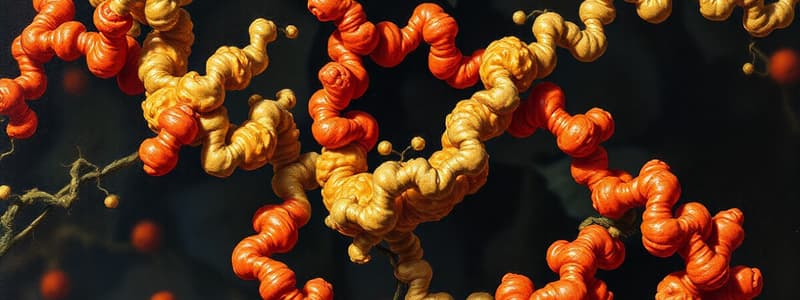Podcast
Questions and Answers
Which level of protein structure involves the linear sequence of amino acids?
Which level of protein structure involves the linear sequence of amino acids?
- Quaternary structure
- Tertiary structure
- Primary structure (correct)
- Secondary structure
The secondary structure of proteins is stabilized by hydrogen bonds between the R-groups.
The secondary structure of proteins is stabilized by hydrogen bonds between the R-groups.
False (B)
What structural feature characterizes the tertiary structure of proteins?
What structural feature characterizes the tertiary structure of proteins?
Overall 3D conformation of the polypeptide chain
The bonds that link amino acids together in a protein are called __________.
The bonds that link amino acids together in a protein are called __________.
Match the following protein structures with their descriptions:
Match the following protein structures with their descriptions:
What is the primary role of enzymes in biological reactions?
What is the primary role of enzymes in biological reactions?
Disulfide bonds are only formed under reducing conditions.
Disulfide bonds are only formed under reducing conditions.
What is the significance of the hydrophobic nature of the interior of proteins?
What is the significance of the hydrophobic nature of the interior of proteins?
The addition of carbohydrate groups to proteins is known as __________.
The addition of carbohydrate groups to proteins is known as __________.
Match the following protein modifications with their descriptions:
Match the following protein modifications with their descriptions:
Flashcards
Primary Structure
Primary Structure
The unique sequence of amino acids in a protein.
Secondary Structure
Secondary Structure
Local folding patterns of the polypeptide chain, stabilized by hydrogen bonds between backbone atoms.
Tertiary Structure
Tertiary Structure
The overall 3D shape of a single polypeptide chain, determined by interactions between R-groups.
Quaternary Structure
Quaternary Structure
Signup and view all the flashcards
Peptide Bond
Peptide Bond
Signup and view all the flashcards
Disulfide Bond
Disulfide Bond
Signup and view all the flashcards
Protein Folding
Protein Folding
Signup and view all the flashcards
Enzymes
Enzymes
Signup and view all the flashcards
Phosphorylation
Phosphorylation
Signup and view all the flashcards
Study Notes
Protein Structure and Function
- Proteins are polymers of 20 amino acids.
- Amino acid sequence dictates protein shape, which defines function.
- Minor amino acid substitutions may not significantly alter protein function.
- Peptide bonds form via condensation reactions (loss of water).
- Peptide bonds have partial double bond characteristics, affecting protein flexibility.
- Protein structure is categorized into four levels: primary, secondary, tertiary, and quaternary.
Primary Structure
- Linear sequence of amino acids.
Secondary Structure
- Local folding patterns of polypeptide chains.
- Stabilized by hydrogen bonds along the polypeptide backbone.
- No interaction between R-groups.
- Common secondary structures are alpha-helices (helix-shaped coils) and beta-sheets (folded, pleated sheets).
- Alpha helices have hydrogen bonds running parallel to the helix axis.
- Beta sheets can be parallel or antiparallel with hydrogen bonds running perpendicular to the sheets.
- R-groups extend outward.
- Important properties such as hydrophobicity (hydrophobic helix) and amphipathic regions (hydrophobic/hydrophilic) influence folding.
Tertiary Structure
- Overall 3D conformation of the entire polypeptide chain.
- Combination of secondary structures.
- Stabilized by various non-covalent interactions between R-groups (e.g. hydrophobic interactions, van der Waals forces, ionic bonds, hydrogen bonds) and disulfide bonds.
- Disulfide bonds
- Covalent bond between two cysteine residues.
- Forms under oxidized conditions.
- Can be intermolecular (connecting different polypeptide chains) or intramolecular (within the same polypeptide chain)
Quaternary Structure
- Exists in proteins with multiple polypeptide chains (at least two subunits).
- Represents the arrangement and interactions between all subunits.
Protein Folding
- Protein shape is crucial for function.
- Hydrophobic amino acids usually cluster inward, promoting stability.
- Hydrophilic amino acids typically face outward, maximizing interactions with water.
- Proteins spontaneously adopt the lowest energy conformation.
Enzymes
- Proteins that accelerate chemical reactions.
- Do not alter the overall free energy change of a reaction.
- Provide an alternative pathway with lower activation energy.
Protein Modifications
- Many proteins undergo post-translational modifications, especially in eukaryotes.
- Disulfide bond formation
- Hydroxylation (adding a hydroxyl group)
- Ubiquitination (marking for degradation)
- Phosphorylation/dephosphorylation (adding/removing a phosphate group)
- Glycosylation (adding sugar chains)
- Proteolytic processing (removing portions of the polypeptide) - Important for protein activation and regulation.
- Modifications are often important for regulating protein function.
Example Protein Modifications
- Phosphorylation:
- Amino acids targeted: Serine, Threonine, Tyrosine.
- Glycosylation:
- Adds carbohydrate groups, creating more complex structures.
- Amino acids targeted: Asparagine, Serine, Threonine, Hydroxylysine.
- Often found on secreted proteins.
- Proteolytic Processing:
- Removal of polypeptide segments.
- Frequently found in proteins activated under specific conditions or locations (eg insulin; HIV Envelope).
Studying That Suits You
Use AI to generate personalized quizzes and flashcards to suit your learning preferences.



